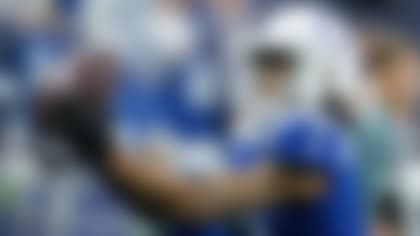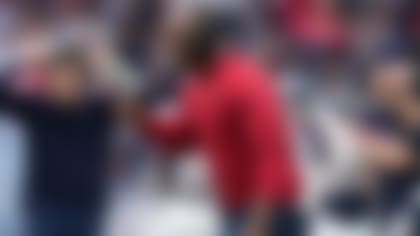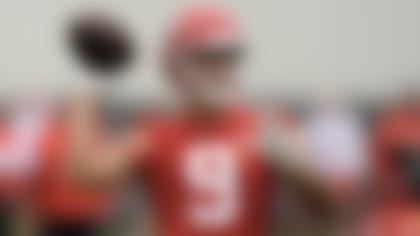Antwan Odom insists he isn't looking to cause an injury, but he has a job to do.
The Cincinnati Bengals pay him to sack the quarterback, and that, he will tell you, must be his singular focus. Beating a blocker is tough enough without having to think about whether he'll draw a flag for how he gets the passer to the ground.
Woodson: Rules impact game
When I look at this so-called "Brady Rule," I think the integrity of the game is in jeopardy. As a defender, where do you hit the QB?
I think it's unfair for the defender, and the QBs never have to think about their legs getting hit, so they can always can step through on throws. That's why I respect the old-school players more so than the new-school players. I respect what Tom Brady and Peyton Manning have done, but they're not getting hit. And if they do, it's a penalty. Either way it affects the outcome of the game.
I understand the safety aspect of the rule and the game and keeping guys safe. But the integrity of the game should be intact, also. I think you're losing that by overprotecting QBs.
What they want defenders to do in the league today is play under control. But all the best players play on that edge. What they want a 300-pound defender to do is stop in his tracks. It's unfair. I understand this is a QB-driven league, but they only make up a small portion of the players in the league.
-- Rod Woodson
"I just don't worry about it," said Odom, whose eight sacks tie him with Denver's Elvis Dumervil for the league lead. "If I've got to dive at his legs, I'm going to do it. I just have to suffer the consequences later. Hopefully, I won't hurt him. If I don't hurt him, there should be no harm and foul."
That isn't how the NFL or its officials see it, though. If a defender dives at a quarterback's legs or makes any sort of contact with his head, he likely will suffer the consequences of a 15-yard penalty for roughing the passer and/or a possible fine.
His contact doesn't even necessarily have to be flagrant, as was the case with two of the more controversial roughing-the-passer penalties in recent memory. Baltimore Ravens defensive tackle Haloti Ngata and outside linebacker Terrell Suggs each drew flags for what, at best, seemed like incidental contact with New England Patriots quarterback Tom Brady last Sunday.
Ngata grazed the side of Brady's helmet, and was penalized after the quarterback made what Ngata described to reporters as an intentional flop to the ground. Suggs barely bumped into Brady's legs, and after the quarterback hopped out of his way, he called for and received another flag. Both penalties kept alive Patriot touchdown drives and caused Ngata, Suggs, some of their teammates, and Ravens coach John Harbaugh to publicly complain about the nature of the calls after the Ravens' 27-21 loss. Harbaugh went as far as to question the NFL's credibility when such innocuous-looking plays result in penalties.
The Ravens' collective outrage sparked a national media debate, most of which has been centered on inconsistencies when it comes to the quarterback being fouled and the officials making the call.
During the offseason, the NFL determined it needed to step up its efforts to protect quarterbacks. It's no secret that that stemmed from the hit to the knee that Brady took from then-Kansas City Chiefs safety Bernard Pollard in the first game of the 2008 season. Brady suffered a torn anterior cruciate ligament that knocked him out for the rest of the year, and that set the wheels in motion for what is widely known as "The Brady Rule."
Odom, who isn't regarded as a dirty player, thinks NFL rules-makers and enforcers "put a little bit more emphasis on (quarterback protection) than they should." He saw replays of the Suggs penalty. He didn't see himself doing anything differently if he were in the same position as his fellow AFC North pass-rusher.
"He beat the blocker, and when you get to the quarterback, you've got to do whatever you can," Odom said. "The quarterback's scrambling or whatever he's doing trying to avoid the sack, so you've got to do whatever you can do to try to get him down. If you're going at his legs, that's just part of the game. It's a physical game."
However, is it too physical when a marquee quarterback is involved? On the same day that Ngata and Suggs were penalized, several other quarterbacks -- including Baltimore's Joe Flacco -- took multiple hard hits that did not result in penalties.
"Kyle Boller's not going to get the same respect as a Peyton Manning," New York Jets defensive tackle Marques Douglas said of the St. Louis Rams quarterback. "I mean, that's just the way it goes. I'm not going to say you can overtly hit him late, but you can place a hit on him that probably won't be called. But if you come anywhere near Peyton Manning, you know they're going to call it because he means too much to the league. They're not going to let you come near him."
But is that true with all officiating crews? Questions have been raised throughout the league about how different officials enforce Rule 12, Section 2, Article 13 of the "2009 Official Playing Rules and Casebook of the National Football League" that states: "A rushing defender is prohibited from forcibly hitting in the knee area or below a passer who has one or both feet on the ground, even if the initial contact is above the knee. It is not a foul if the defender is blocked (or fouled) into the passer and has no opportunity to avoid him … A defender cannot initiate a roll or lunge and forcibly hit the passer in the knee area or below, even if he is being contacted by another player … It is not a foul if the defender swipes, wraps, or grabs a passer in the knee area or below in an attempt to tackle him."
According to Mike Pereira, the NFL's vice president of officiating, a clear target area for defensive players has been established: Above the knees and below the neck. He said referees are instructed to penalize any defender working outside of those parameters, even if they're uncertain about whether a penalty has truly been committed.
"And we're not going to back off that," Pereira said. "We don't put, necessarily, judgment into it, although, with the low hits, we do understand that there are going to be hits that are not forcible hits. So we put that in the rule that says in order for it to be a foul, the hit has to be forcible. But that's purely at the judgment of the referee, and nobody else's judgment. And we follow that same logic when we said to the referees, 'If there's any doubt as to whether or not the hit is a foul, call it a foul. Err on the side of safety.' You're not going to have 100-percent, consistent application of judgment. That's not possible, and to think it is possible is ludicrous."
Said St. Louis Rams coach Steve Spagnuolo, "Is it hard to officiate? You'd have to ask the officials. I would think it would be, if I was doing that. It's probably pretty difficult. I guess if they were ruling it the same way all the way clear across the board, then we all have to abide by it and live with what the officials say. With any rule, if it's not officiated consistently -- both sides, each game, game to game -- I think that is when you start to have questions."
Coaches, club executives, and players are pretty much resigned to the fact there are certain officiating crews that are more inclined to call more penalties in general than others and take the league's when-in-doubt-throw-the-flag guidance on roughing-the-passer calls more literally than others. It is why players receive scouting reports on officials, as well as on their opponents.
Referee Ron Winter and his crew of officials, who worked last Sunday's Ravens-Patriots game, have called the highest number of penalties in the league the past two years, according to Colts president Bill Polian, a member of the NFL's Competition Committee.
"And I have no quarrel with that, by the way," Polian said. "It's reasonable to assume that there will be some inconsistency, which is why they have the caveat, 'If in doubt, throw the flag. Err on the side of caution in protecting the quarterbacks.' Nobody argues against that. They are the most important guys.
"We don't like inconsistency, but … it's a human condition. That's why there is the fine mechanism on the back end at the league office. When a dangerous play is missed, they turn around and (issue a fine) if the player isn't found to be in violation (immediately) after the fact."
Odom is certain a dangerous play was missed during the Bengals' game against the Cleveland Browns last Sunday.
"They roughed Carson (Palmer) up a little bit, and we didn't get a call and I thought that was the wrong (non-) call to make because they should have made the call on that," Odom said. "It just depends on the officials, I think. Some officials look at it real close and some let stuff fly."
According to Pereira, many playing rules have been put into place for the protection of all players, not just quarterbacks. But he did say, over time, the quarterback has become the focus of greater attention because of his vulnerability.
"When he's in the pocket, he's a player that's not looking at defensive players coming at him; he's looking downfield at his receivers," Pereira said. "And in many cases, he's planting and throwing and has been put in an awkward position and, really, not suited to take a blow."
That, he stressed, goes for all quarterbacks, not just a select few. "It doesn't even merit a response from me about somebody that says that we're showing favoritism for any particular player," Pereira said. "To say that is challenging our integrity. And our integrity, as far as I'm concerned, is above board and the highest of any level in this game."
Coaches take responsibility for instructing players to be mindful about how they make contact with the quarterback. Their primary concern is avoiding a 15-yard penalty, which, after a deep pass-interference call, is the most damaging infraction a team can receive.
All teams go over rules changes and points of emphasis in training camp. Officiating crews go from team to team to show players video clips of certain infractions and explain how they will be enforced.
When it comes to hitting quarterbacks, New York Giants defensive line coach Mike Waufle stages an "Alligator Tackling Drill," in which members of his unit wrap their arms around a large blue tackling dummy and roll with it to the ground -- as if wrestling with an alligator -- rather than slamming it down.
"Number one, you don't get a free shot at the quarterback, and that's where it's got to start," Bengals coach Marvin Lewis said. "You have to understand that, if you know he's throwing the football, your best bet is to pull off. That's a change. Two or three years ago, guys thought, 'Just because I'm close to the quarterback, and he's releasing the football, I get a chance to hit him.' You can't do that now. It's for the good of the game that these guys are hundred-million-dollar investments being protected. And that's the way the owners want it done and that's the way it's being done."
There is, of course, a limit to how much emphasis to place on caution. After all, the last thing any team wants is passive pass-rushers.
"If you go down that road too often, you run the risk of losing the aggressiveness, which is what defensive football is all about," Spagnuolo said. "It's a fine line."
"Are we impinging on the integrity of the game?" Pereira said. "I don't believe so. I believe our game is made up of great players, and our game is at its best when these great players are in the game, whether it's offensively or defensively. And you're not going to see a letup from our guys from the officiating standpoint, and you're certainly not going to see a back track of the rules."




